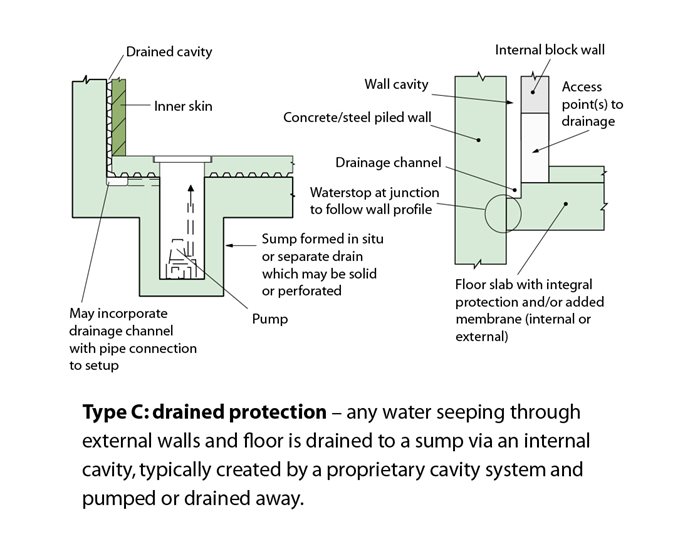Type C (Drained) System

Type C construction relies on water being resisted by the structural elements and any water that penetrates the external shell of the structure being collected in a cavity formed between the external wall and an internal lining/wall. There is permanent reliance on this cavity to collect groundwater seepage and direct it to a suitable discharge point, e.g. drains or a sump for removal by gravity drainage or mechanical pumping. The amount of free water entering the cavity will depend on the volume of external water and its hydrostatic pressure, and on the resistance of the structure itself to water ingress. Designers need to consider any risk associated with a constant supply of possible contaminated water to the structure.
Such systems typically remove water via a mechanical sump pump system, or occasionally by gravity to low ground or drains externally where properties are formed into sloping sites. However, the need to control ground gases, e.g. radon, may not allow the use of gravity drainage. In all cases, consideration should be given to the point at which water discharges, understanding that the effectiveness of the system is reliant on removal of water, so an appraisal of this factor is required.
Type C pumped systems should be engineered to cope with worst-case water ingress. If drainage capacity is exceeded, this may result in dampness or flooding. Type C systems are designed to control and manage leakage and seepage into a structure where water ingress unacceptably high, the water resistance of the structure should be improved by remedial measures prior to the installation of the type C system.
Backup pumps and alarms should in most situations be included, particularly where the consequences of failure are great. It should also be noted that:
- Type C systems require a maintenance schedule, as failure of mechanical pumps could result in flooding;
- blockage of the cavity by silt or lime or other contaminants could result in flooding. (The design of the system should allow for clearing of silt should blockages occur in the system including discharging drains.)
Maintenance should be undertaken by a specialist, making assessment of the requirement to upgrade and replace pumps as necessary.
When combining systems in order to minimise the risks or negate the need for remedial measures, consideration should be given to the compatibility of the combining systems.
Further information is available from our guidance document Basements: Waterproofing